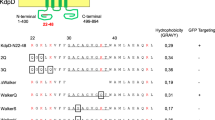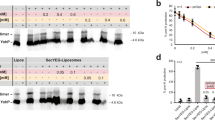Abstract
Small G proteins have key roles in signal transduction pathways. They are switched from the signaling 'on' to the non-signaling 'off' state when GTPase-activating proteins (GAPs) provide a catalytic residue. The ancient signal recognition particle (SRP)-type GTPases form GTP-dependent homo- and heterodimers and deviate from the canonical switch paradigm in that no GAPs have been identified. Here we show that the YlxH protein activates the SRP-GTPase FlhF. The crystal structure of the Bacillus subtilis FlhF–effector complex revealed that the effector does not contribute a catalytic residue but positions the catalytic machinery already present in SRP-GTPases. We provide a general concept that might also apply to the RNA-driven activation of the universally conserved, co-translational protein-targeting machinery comprising the SRP-GTPases Ffh and FtsY. Our study exemplifies the evolutionary transition from RNA- to protein-driven activation in SRP-GTPases and suggests that the current view on SRP-mediated protein targeting is incomplete.
This is a preview of subscription content, access via your institution
Access options
Subscribe to this journal
Receive 12 print issues and online access
$189.00 per year
only $15.75 per issue
Buy this article
- Purchase on Springer Link
- Instant access to full article PDF
Prices may be subject to local taxes which are calculated during checkout



Similar content being viewed by others
References
Leipe, D.D., Wolf, Y.I., Koonin, E.V. & Aravind, L. Classification and evolution of P-loop GTPases and related ATPases. J. Mol. Biol. 317, 41–72 (2002).
Lutkenhaus, J. Assembly dynamics of the bacterial MinCDE system and spatial regulation of the Z ring. Annu. Rev. Biochem. 76, 539–562 (2007).
Montoya, G., Svensson, C., Luirink, J. & Sinning, I. Crystal structure of the NG domain from the signal-recognition particle receptor FtsY. Nature 385, 365–368 (1997).
Freymann, D.M., Keenan, R.J., Stroud, R.M. & Walter, P. Structure of the conserved GTPase domain of the signal recognition particle. Nature 385, 361–364 (1997).
Bange, G., Petzold, G., Wild, K., Parlitz, R.O. & Sinning, I. The crystal structure of the third signal-recognition particle GTPase FlhF reveals a homodimer with bound GTP. Proc. Natl. Acad. Sci. USA 104, 13621–13625 (2007).
Grudnik, P., Bange, G. & Sinning, I. Protein targeting by the signal recognition particle. Biol. Chem. 390, 775–782 (2009).
Cross, B.C., Sinning, I., Luirink, J. & High, S. Delivering proteins for export from the cytosol. Nat. Rev. Mol. Cell Biol. 10, 255–264 (2009).
Egea, P.F. et al. Substrate twinning activates the signal recognition particle and its receptor. Nature 427, 215–221 (2004).
Focia, P.J., Shepotinovskaya, I.V., Seidler, J.A. & Freymann, D.M. Heterodimeric GTPase core of the SRP targeting complex. Science 303, 373–377 (2004).
Zhang, X., Schaffitzel, C., Ban, N. & Shan, S.O. Multiple conformational switches in a GTPase complex control co-translational protein targeting. Proc. Natl. Acad. Sci. USA 106, 1754–1759 (2009).
Wild, K., Halic, M., Sinning, I. & Beckmann, R. SRP meets the ribosome. Nat. Struct. Mol. Biol. 11, 1049–1053 (2004).
Powers, T. & Walter, P. Reciprocal stimulation of GTP hydrolysis by two directly interacting GTPases. Science 269, 1422–1424 (1995).
Peluso, P., Shan, S.O., Nock, S., Herschlag, D. & Walter, P. Role of SRP RNA in the GTPase cycles of Ffh and FtsY. Biochemistry 40, 15224–15233 (2001).
Siu, F.Y., Spanggord, R.J. & Doudna, J.A. SRP RNA provides the physiologically essential GTPase activation function in cotranslational protein targeting. RNA 13, 240–250 (2007).
Bradshaw, N., Neher, S.B., Booth, D.S. & Walter, P. Signal sequences activate the catalytic switch of SRP RNA. Science 323, 127–130 (2009).
de Leeuw, E. et al. Anionic phospholipids are involved in membrane association of FtsY and stimulate its GTPase activity. EMBO J. 19, 531–541 (2000).
Stjepanovic, G. et al. Lipids trigger a conformational switch that regulates signal recognition particle (SRP)-mediated protein targeting. J. Biol. Chem. 286, 23489–23497 (2011).
Ataide, S.F. et al. The crystal structure of the signal recognition particle in complex with its receptor. Science 331, 881–886 (2011).
Kirkpatrick, C.L. & Viollier, P.H. Poles apart: prokaryotic polar organelles and their spatial regulation. Cold Spring Harb. Perspect. Biol. 3 (2011).
Murray, T.S. & Kazmierczak, B.I. FlhF is required for swimming and swarming in Pseudomonas aeruginosa. J. Bacteriol. 188, 6995–7004 (2006).
Carpenter, P.B., Hanlon, D.W. & Ordal, G.W. flhF, a Bacillus subtilis flagellar gene that encodes a putative GTP-binding protein. Mol. Microbiol. 6, 2705–2713 (1992).
Pandza, S. et al. The G-protein FlhF has a role in polar flagellar placement and general stress response induction in Pseudomonas putida. Mol. Microbiol. 36, 414–423 (2000).
Correa, N.E., Peng, F. & Klose, K.E. Roles of the regulatory proteins FlhF and FlhG in the Vibrio cholerae flagellar transcription hierarchy. J. Bacteriol. 187, 6324–6332 (2005).
Kusumoto, A. et al. Regulation of polar flagellar number by the flhF and flhG genes in Vibrio alginolyticus. J. Biochem. 139, 113–121 (2006).
Green, J.C. et al. Recruitment of the earliest component of the bacterial flagellum to the old cell division pole by a membrane-associated signal recognition particle family GTP-binding protein. J. Mol. Biol. 391, 679–690 (2009).
Nowalk, A.J., Gilmore, R.D. Jr. & Carroll, J.A. Serologic proteome analysis of Borrelia burgdorferi membrane-associated proteins. Infect. Immun. 74, 3864–3873 (2006).
Kusumoto, A. et al. Collaboration of FlhF and FlhG to regulate polar-flagella number and localization in Vibrio alginolyticus. Microbiology 154, 1390–1399 (2008).
Scheffzek, K. et al. The Ras-RasGAP complex: structural basis for GTPase activation and its loss in oncogenic Ras mutants. Science 277, 333–338 (1997).
Wittinghofer, A. Signaling mechanistics: aluminum fluoride for molecule of the year. Curr. Biol. 7, R682–R685 (1997).
Gasper, R., Meyer, S., Gotthardt, K., Sirajuddin, M. & Wittinghofer, A. It takes two to tango: regulation of G proteins by dimerization. Nat. Rev. Mol. Cell Biol. 10, 423–429 (2009).
Focia, P.J., Gawronski-Salerno, J., Coon, J.S.T. & Freymann, D.M. Structure of a GDP:AlF4 complex of the SRP GTPases Ffh and FtsY, and identification of a peripheral nucleotide interaction site. J. Mol. Biol. 360, 631–643 (2006).
Fersht, A. Enzyme Structure and Mechanism (W.H. Freeman, San Francisco, 1977).
Bourne, H.R., Sanders, D.A. & McCormick, F. The GTPase superfamily: a conserved switch for diverse cell functions. Nature 348, 125–132 (1990).
Vetter, I.R. & Wittinghofer, A. The guanine nucleotide-binding switch in three dimensions. Science 294, 1299–1304 (2001).
Daumke, O., Weyand, M., Chakrabarti, P.P., Vetter, I.R. & Wittinghofer, A. The GTPase-activating protein Rap1GAP uses a catalytic asparagine. Nature 429, 197–201 (2004).
Kimple, A.J., Bosch, D.E., Giguere, P.M. & Siderovski, D.P. Regulators of G-protein signaling and their Gα substrates: promises and challenges in their use as drug discovery targets. Pharmacol. Rev. 63, 728–749 (2011).
Liu, R. & Ochman, H. Origins of flagellar gene operons and secondary flagellar systems. J. Bacteriol. 189, 7098–7104 (2007).
del Campo, A.M. et al. Chemotactic control of the two flagellar systems of Rhodobacter sphaeroides is mediated by different sets of CheY and FliM proteins. J. Bacteriol. 189, 8397–8401 (2007).
Bohnsack, M.T. & Schleiff, E. The evolution of protein targeting and translocation systems. Biochim. Biophys. Acta 1803, 1115–1130 (2010).
Walter, P., Keenan, R. & Schmitz, U. Perspectives: structural biology. SRP–where the RNA and membrane worlds meet. Science 287, 1212–1213 (2000).
James, P., Halladay, J. & Craig, E.A. Genomic libraries and a host strain designed for highly efficient two-hybrid selection in yeast. Genetics 144, 1425–1436 (1996).
Collaborative Computational Project. N.. The CCP4 suite: programs for protein crystallography. Acta Crystallogr. D Biol. Crystallogr. 50, 760–763 (1994).
Emsley, P. & Cowtan, K. Coot: model-building tools for molecular graphics. Acta Crystallogr. D Biol. Crystallogr. 60, 2126–2132 (2004).
Adams, P.D. et al. PHENIX: a comprehensive Python-based system for macromolecular structure solution. Acta Crystallogr. D Biol. Crystallogr. 66, 213–221 (2010).
Kanehisa, M., Goto, S., Furumichi, M., Tanabe, M. & Hirakawa, M. KEGG for representation and analysis of molecular networks involving diseases and drugs. Nucleic Acids Res. 38, D355–D360 (2010).
Bailey, T.L., Boden, M., Whitington, T. & Machanick, P. The value of position-specific priors in motif discovery using MEME. BMC Bioinformatics 11, 179 (2010).
Bailey, T.L. & Gribskov, M. Combining evidence using p-values: application to sequence homology searches. Bioinformatics 14, 48–54 (1998).
Larkin, M.A. et al. Clustal W and Clustal X version 2.0. Bioinformatics 23, 2947–2948 (2007).
Paradis, E., Claude, J. & Strimmer, K. APE: Analyses of phylogenetics and evolution in R language. Bioinformatics 20, 289–290 (2004).
Acknowledgements
This work was supported by the German Research Council SFB638 (I.S.), the Graduiertenkolleg GRK1188 and the interdisciplinary PhD program “Molecular Machines: Mechanisms and Functional Interconnections” of the Land Baden-Württemberg (I.S.). I.S. and E.H. are investigators of the Cluster of Excellence:CellNetworks. We are grateful to A. Hendricks for her excellent technical assistance, U. Pachmayr for her contribution in the beginning of the project and R. Pipkorn (Deutsches Krebsforschungszentrum) for peptide synthesis. We thank J. Kopp and C. Siegmann from the BZH/Cluster of Excellence: CellNetworks crystallization platform for their support and E. Thomson for critical reading of the manuscript. Data collection was performed at ESRF beamline ID14-4 (European Synchrotron Radiation Facility).
Author information
Authors and Affiliations
Contributions
G.B. and I.S. designed the experiments, analyzed the data and wrote the manuscript. G.B. and N.K. performed the experiments. D.K. and E.H. provided the yeast-two hybrid analysis. P.G. and G.P. contributed to the activation assays. G.B., K.W. and I.S. performed crystallographic analysis. R.L. performed the computational analysis. All authors commented on the manuscript.
Corresponding authors
Ethics declarations
Competing interests
The authors declare no competing financial interests.
Supplementary information
Supplementary Text and Figures
Supplementary Figures 1–11 (PDF 782 kb)
Rights and permissions
About this article
Cite this article
Bange, G., Kümmerer, N., Grudnik, P. et al. Structural basis for the molecular evolution of SRP-GTPase activation by protein. Nat Struct Mol Biol 18, 1376–1380 (2011). https://doi.org/10.1038/nsmb.2141
Received:
Accepted:
Published:
Issue Date:
DOI: https://doi.org/10.1038/nsmb.2141
This article is cited by
-
Inhibition of SRP-dependent protein secretion by the bacterial alarmone (p)ppGpp
Nature Communications (2022)
-
The E. coli MinCDE system in the regulation of protein patterns and gradients
Cellular and Molecular Life Sciences (2019)
-
Biochemical analysis of GTPase FlhF which controls the number and position of flagellar formation in marine Vibrio
Scientific Reports (2018)
-
SIMIBI twins in protein targeting and localization
Nature Structural & Molecular Biology (2013)



